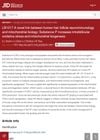Search
forLearn
5 / 6 resultslearn Melatonin
hormone commonly taken for sleep aid has some topical benefits for hair
learn Azelaic Acid
acid used for antimicrobial, anti-inflammatory and anti-androgenic properties
learn Neem Oil
natural substance from Neem tree with medicinal and pesticidal properties
learn Epidermal Growth Factor
Research
5 / 1000+ results
research Epithelial Loss of Mitochondrial Oxidative Phosphorylation Leads to Disturbed Enamel and Impaired Dentin Matrix Formation in Postnatal Developed Mouse Incisor
Mitochondrial problems in tooth cells lead to bad enamel and dentin development in mice.
research Copper Modulates Mitochondrial Oxidative Phosphorylation to Enhance Dermal Papilla Cell Proliferation in Rex Rabbits
Copper boosts cell growth in rabbit hair follicles.

research Regulation of Mitochondrial Oxidative Metabolism by Tumor Suppressor FLCN
The tumor suppressor gene FLCN affects mitochondrial function and energy use in cells.

research A Novel Link Between Human Hair Follicle Neuroimmunology and Mitochondrial Biology: Substance P Increases Intrafollicular Oxidative Stress and Mitochondrial Biogenesis
Substance P may contribute to hair loss by increasing oxidative stress and mitochondrial activity in hair follicles.
research Environmental Pollution, Oxidative Stress, and Thioretinaco Ozonide: Effects of Glyphosate, Fluoride, and Electromagnetic Fields on Mitochondrial Dysfunction in Carcinogenesis, Atherogenesis, and Aging
Environmental pollutants like glyphosate, fluoride, and electromagnetic fields can cause health problems by damaging mitochondria and affecting metabolism.
Community Join
5 / 108 resultscommunity How ET-02 Works. Also no proof that it's better than Minoxidil. At least for now.
ET-02, a PAI-1 inhibitor, is not proven to be more effective than Minoxidil for hair loss. Other treatments like finasteride, dutasteride, PP405, and AMP-303 are also discussed, focusing on cellular senescence and oxidative stress.
community PP405 Won't Work Long Term: Hair Follicle Damage Due to Abuse of the ISR System
PP405 may damage hair follicles if used long-term, suggesting cycling might be necessary. Combining it with finasteride could help maintain hair growth.
community How likely do you think it is for PP405 to come out?
PP405 is a potential new hair loss treatment that works through metabolic pathways rather than hormonal ones, with an estimated market release between late 2027 and 2029. Current alternatives to finasteride include minoxidil, pyralutamide, fluridil, and RU58841, with hair transplants also being a viable option.
community If PP405 goes systemic this would be quite catastrophic
Concerns about the potential systemic effects and safety of PP405 for hair loss, with discussions on its comparison to existing treatments like finasteride and minoxidil. Users express skepticism about untested research chemicals and emphasize the importance of clinical trials to ensure safety and efficacy.
community Potential ( but not yet confirmed ) pp405 leak through korean media.
A peptide-based hair loss treatment, PP405, reportedly increased hair density by 62% in 90 days, but these claims are unverified and met with skepticism. Users compared PP405 to Minoxidil and Finasteride, expressing doubts about its effectiveness without more evidence.